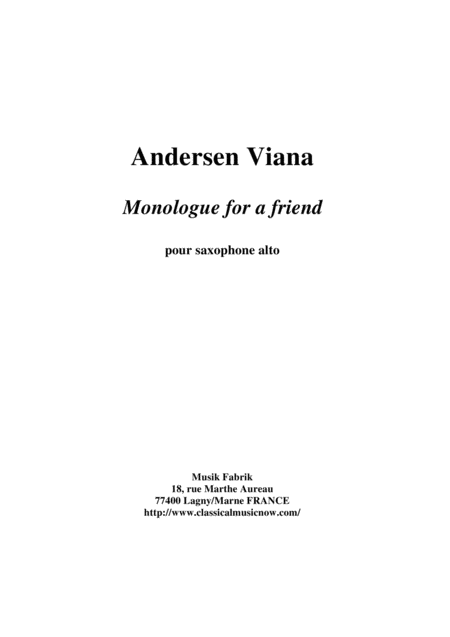Alto Saxophone Solo - Level 5 - Digital Download SKU: A0.533545 Composed by Andersen Viana. 20th Century,Concert,Standards. Individual part. 7 pages. Musik Fabrik Music Publishing #3017637. Published by Musik Fabrik Music Publishing (A0.533545). This was the first piece composed for the saxophone by ANDERSEN VIANA. The piece uses two contrasting sections: one related to violence and psychological instability in the big cities, and other; related to the nostalgic moods found in Rio de Janeiro in the past. It was composed specially for a friend, saxophonist and Doctor Mecenas MAGNO. Monologue for a friend is a rhapsodic and brilliant piece of great effect, also using rhythms and reminiscences of the music called Choros and Samba so popular in the Rio de Janeiro city at the 40’ths and 50'ths. It uses also free structures and little allusions to minimalism of Riley and Reich. The work is divided in six sections: Tormentà to, Scherzando, Lento, Lentissimo, reexposition (Tormentà to) and Coda. Born in Belo Horizonte, Minas Gerais, he has a Ph.D. in Music Composition from the Federal University of Bahia. He began composing at the age of thirteen and became a professor at the age of nineteen. He has studied in courses and seminars about music and film in several official institutions with Ennio Morricone, Ettore Scolla, Giussepe Tornatore, E. Polizzi, Radamés Gnatalli, Max Rostal, Oilliam Lanna, S. Vianna (Accademia Chigiana di Siena, Reale Accademia Filarmonica di Bologna, Arts Academy of Rome, Royal University College of Music Stockholm, UFMG, UFBA), among others. He currently works as a composer-conductor and cultural producer, as well as a professor at the Clóvis Salgado Foundation, Palácio das Artes, in Belo Horizonte, Brazil, in addition to offering lectures and workshops in various institutions both in Brazil and abroad. His first teacher wa his father, Sebastião Vianna (assistant and reviser for the Brazilian composer, Heitor Villa-Lobos), and most recently furthered his studies in other institutions in Brazil, Italy, and Sweden. He has also published over forty articles both in Brazil and Europe. Viana has received 25 awards in Argentina, Brazil, Europe and the USA, including the Prix de Composition at the First Composition Competition Festin Choral 2013 in the city of Billère (France), first prize at the Susanville Symphony Composition Competition 2012 (USA), first prize in the international composition contest of Lys Music Orchestra 2001 in Belgium, first prize and the audience prize in the Lambersart 2006 International Contest of Composition in France. To date, he has composed 315 musical pieces for voices, chamber, symphonic as well as electronic instruments. Viana has also composed film scores for the following films: A Cartomante, Retalhos do Taquaril, Bem Próximo do Mal (Next Evil), Jogando para o Amanhã, O Próximo Passo, Gun’s Speech, Trem Fantasma, 3:00:AM, Corações Ardentes, Filhos de Adão, Perdidos em Abbey Road, Vivalma, Manuelzão e Bananeira, Ofélia, Opostos, Minas Portuguesa, O Homem da Cabeça de Papelão, Convict, Ser Humano (Human Being), Um Dia Qualquer, Nego, Reenactment, Desafios and Oswaldo França Júnior.
